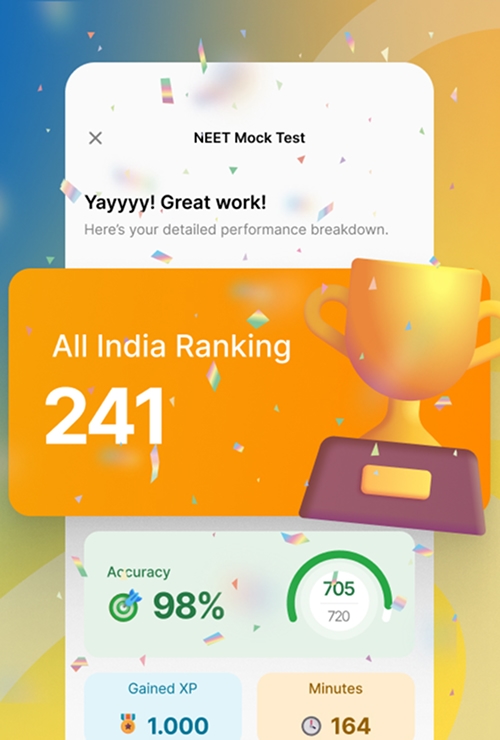
☝️ At a glance
- Involves years of study, from pre-medical schooling to medical school, residency, and continuous learning through specialization.
- High salary, job security, personal fulfillment, diverse work environments, and opportunities for research and global impact are some pros.
- High education costs, demanding work-life balance, emotional stress, and potential burnout from long hours are some cons.
- India offers cost-effective education but faces intense competition and limited resources, while studying abroad offers advanced training but with higher costs and cultural adjustments.
- Despite high education costs, the long-term financial and personal benefits, including career stability and global opportunities, often outweigh the initial investment.
Becoming a doctor is a dream many pursue with passion, but it’s natural for aspiring doctors to ask, "Is becoming a doctor worth it?" This question goes beyond financial investment, touching on personal satisfaction, challenges, and long-term career prospects. In this guide, we’ll explore "Is becoming a doctor worth it?", considering factors like time, cost, and how it aligns with your personal goals. By the end, you’ll have a clearer sense of whether the path to being a doctor fits your ambitions and life satisfaction.

Become a global doctor with MBBS abroad!
Studying abroad can be affordable and stress-free with futureMBBS:
- World-recognized universities with English-taught programs
- On-site support in partner university cities
- Guaranteed placements & internships for hands-on experience
From selecting universities and supporting you with the application process to orientation and finding accommodation – we are at your side.
Roadmap to becoming a doctor
Starting on the journey to becoming a doctor involves several key steps:
1. Pre-medical study
Before entering medical school, students typically complete schooling, often in a science-related field. During this phase, you’ll dive into subjects like biology, chemistry, and physics, building a solid understanding of the human body and laying the foundation for your future medical practice.
2. Medical school
Medical school generally lasts four years and is divided into two main phases: pre-clinical and clinical. In the pre-clinical phase, students dive into the basics of medical sciences like anatomy, pharmacology, and pathology—it's really just the beginning. Later, the clinical phase gives hands-on experience in specialties like internal medicine, surgery, and pediatrics, helping future physicians build real-world skills.
3. Residency programs
After medical school, graduates enter residency, which provides specialized guidance in their chosen field. Residency programs typically last between three to seven years, depending on the specialty. This phase is critical for gaining practical experience and honing clinical skills.
4. Licensure and board certification
To practice medicine, a doctor must pass licensing exams specific to their country or region. In the United States, this involves passing the United States Medical Licensing Examination (USMLE). Additionally, a doctor obtains board certification in their specialty, which demonstrates advanced knowledge and skills.
5. Continuing education
Medicine is a constantly evolving field, requiring a doctor to engage in lifelong learning. Continuing medical education (CME) ensures that a doctor stays updated on new treatments, technologies, and best practices.

Study medicine abroad with 100% support!
futureMBBS offers full support to make your dream of studying medicine abroad a reality.
- Hassle-free admission guidance
- Fast-tracked visa processing
- Post-arrival support, including accommodation assistance
Benefits of being a doctor
Choosing a medical career comes with numerous benefits, including:

- High salary
A doctor can typically earn high compared to many other professions. The financial rewards of a medical career can provide a comfortable lifestyle and financial stability. According to the Bureau of Labor Statistics, physicians and surgeons are among the highest-paid professionals.
- Job security
The demand for health workers remains strong due to an aging population and increasing healthcare needs. This demand translates to stable employment for a doctor, even during economic downturns.
- Personal satisfaction
One of the greatest rewards when you become a doctor is the chance to truly make a difference in patients' lives. Many physicians find deep personal satisfaction in caring for others, easing their pain, and improving their overall well-being.
- Continuous learning
The medical field is dynamic and continually evolving. When you become a doctor, the learning never stops. Your natural curiosity is constantly fueled through formal education, attending conferences, or diving into research. This ongoing growth makes the journey of a doctor worth every step.
- Respect and prestige
A doctor is highly respected in society, and the profession carries a certain prestige. This respect can lead to a sense of accomplishment and recognition for one's contributions to healthcare.
- Ability to specialize
When you become a doctor, you have the exciting opportunity to gain experience in specialized fields like cardiology or neurology. This chance to focus on areas you're passionate about not only enhances your expertise but also makes the journey of worth it.
- Opportunities for research
As a medical professional, after you become a doctor it opens doors to participate in groundbreaking research, contributing in new innovations and advancing medical care to improve patient outcomes.
- Impact on public
Unlike few other professions, physicians in the physician workforce directly contribute to the well-being of communities by addressing widespread health issues and promoting healthier lives.
- Diverse work environments
This diversity offers many other opportunities and allows physicians to find a work environment that suits their preferences. Factors contributing to this flexibility include the wide range of settings in which doctors can practice, from hospitals to clinics and research labs.
- Global opportunities
Medical training and qualifications can open doors to international career opportunities, allowing doctors to work in different countries and experiencing different healthcare cultures.
Cons of being a doctor
While the medical career offers many benefits, it also comes with its challenges:
- Medical school costs
The cost of medical study can be substantial, leading to significant student loan debt. Medical school tuition and related expenses can vary widely, but the financial burden is a common concern for many aspiring doctors.
- Demanding nature
The job of physicians can be physically and emotionally demanding. Burnout and fatigue are common with long hours and high stress environments.
- Work-life stability
Achieving a can be challenging due to the long hours and on-call responsibilities that come with being physicians. Support from physician assistant and family is important to balance treating patients and personal life.
- Residency training
Residency program is intense and often requires relocation and long hours. Completing residency is important for developing specialised skills.
- Emotional toll
Dealing with critically ill patients, making difficult decisions, and coping with patient losses can take an emotional toll on doctors. Managing stress and maintaining emotional resilience is essential.
- Legal risks
Physicians are at risk of malpractice lawsuits, which can be stressful and financially burdensome.
- Administrative burden
Increasing administrative responsibilities, including documentation and compliance with regulations, can take time away from patient care. This can be frustrating for many doctors.
- Patient expectations
Managing patient expectations and dealing with difficult patients can be challenging. Balancing patient demands with medical realities requires effective communication and diplomacy.
- Burnout risk
The strenuous nature of the job and the high-pressure environment can lead to burnout. Addressing burnout and finding ways to manage stress is crucial for long-term career satisfaction.
- Career longevity
The physically and mentally strenuous nature of the job can impact career longevity. Some doctors may face challenges in maintaining their health and performance over the long term.
| Aspect | Pros | Cons |
| Salary | High earning potential | High student debt can offset early earnings |
| Job stability | Strong demand for healthcare workforce | Can be affected by economic downturns |
| Personal satisfaction | Making a significant impact on patient’s lives | Emotional toll from dealing with illness and death |
| Work environment | Opportunities in diverse settings | High-stress environment |
| Specialization | Chance to specialize in various fields | Long training and high pressure |
| Global opportunities | Opportunities to work internationally | Licensing and recognition challenges in different countries |
Pros and cons: India vs. Abroad
India
Pros:
- Cost-effective study: Medical study in India is relatively affordable compared to many Western countries. Institutions like AIIMS and government medical colleges offer quality education at lower costs.
- Growing demand: India has a growing demand for health workers due to an increasing population and the dynamic field of healthcare needs.
- Cultural familiarity: Studying and working in India allows doctors and physicians to remain in a familiar cultural and linguistic environment, which can ease the transition into the medical profession.
Cons:
- Intense competition: Entrance exams like NEET are highly competitive, and securing a spot in a reputable medical college can be challenging.
- Work environment: The work environment can be demanding, with high patient loads and long working hours, leading to potential burnout.
- Limited resources: Some medical institutions may face limitations in terms of resources and infrastructure, impacting the quality of care given to patients.
Abroad
Pros:
- Advanced training: Medical schools abroad often provide access to advanced technology and innovative instruction methods.
- Higher salaries: In many countries, doctors and physicians earn higher salaries and receive better benefits, contributing to financial stability.
- Diverse clinical exposure: Medical study abroad can offer exposure to diverse clinical cases and healthcare systems, enriching the learning experience.
Cons:
- Higher costs: Medical study abroad can be expensive, with higher tuition fees and living costs. Additionally, international students may face additional financial burdens.
- Cultural adjustment: Adapting to a new culture and medical system can be challenging for international students.
- Licensing and recognition: Graduates of foreign medical schools may face additional challenges in getting their qualifications recognized and obtaining licensure in their home country.
India
| Pros | Cons |
| Cost-effective education | Intense competition |
| Growing demand | Work environment |
| Cultural familiarity | Limited resources |
Abroad
| Pros | Cons |
| Advanced training | Higher costs |
| Higher salaries | Cultural adjustment |
| Diverse clinical exposure | Licensing and recognition challenges |
Return on investment (ROI) of becoming a doctor
Evaluating the ROI of becoming a doctor and a physician involves assessing both the financial and personal aspects of the career. Although the cost of medical study and student loan can be significant, the long-term benefits like high salaries, stable employment, and the personal satisfaction of helping others often outweigh these initial investments.
Financial considerations
- Tuition costs: Medical school tuition can vary widely. In the United States, tuition can range from $30,000 to $60,000 per year, while in Europe, it may be lower, especially in countries like Hungary or Poland.
- Student loan debt: Many medical students graduate with substantial student debt, so what is crucial is to effectively plan your finances and explore repayment options.
Personal fulfillment
- Job satisfaction: The ability to make a difference in patients' lives and contribute to public health can lead to high job satisfaction.
- Career opportunities: From clinical practice to research and teaching, the medical field offers diverse opportunities.
- Personal growth: This is possible as you encounter the challenges and experiences in the healthcare industry.
- Professional networking: Opportunities to build a strong network are plenty which in turn in beneficial for career advancement.
- Global impact: Doctors and physicians have the chance to make a positive contribution on a global scale, whether through international missions, research, or working in underserved areas.
Cost of education and average salaries of doctors (India vs. Abroad)
| Country | Annual tuition fee (INR lakhs) | Other costs (living, books, etc.) (INR lakhs) | Total estimated cost (INR lakhs) | Average annual salary (General physician) (INR lakhs) | Average annual salary (Surgeon) (INR lakhs) |
| India | 0.10 - 30.00 | 2.00 - 10.00 | 12.00 - 40.00 | 12.00 - 20.00 | 20.00 - 40.00 |
| United States | 30.00 - 50.00 | 10.00 - 20.00 | 40.00 - 70.00 | 120.00 - 180.00 | 240.00 - 300.00 |
| United Kingdom | 20.00 - 30.00 | 7.00 - 15.00 | 27.00 - 45.00 | 60.00 - 80.00 | 100.00 - 150.00 |
| Australia | 15.00 - 25.00 | 8.00 - 12.00 | 23.00 - 37.00 | 80.00 - 120.00 | 150.00 - 200.00 |
| Canada | 15.00 - 30.00 | 5.00 - 10.00 | 20.00 - 40.00 | 70.00 - 100.00 | 150.00 - 200.00 |
| Hungary | 8.00 - 16.00 | 4.00 - 8.00 | 12.00 - 24.00 | 40.00 - 60.00 | 70.00 - 100.00 |
| Czech Republic | 10.00 - 16.00 | 5.00 - 10.00 | 15.00 - 28.00 | 50.00 - 70.00 | 80.00 - 120.00 |
| Poland | 8.00 - 12.00 | 3.00 - 6.00 | 11.00 - 20.00 | 40.00 - 60.00 | 60.00 - 90.00 |
From NEET to MD: the journey in India

The journey to becoming a doctor in India involves several key steps:
NEET examination
The National Eligibility cum Entrance Test (NEET) is a crucial entrance exam for medical colleges in India. It checks how well students understand Physics, Chemistry, and Biology, and is a major factor in getting into medical school. With NEETsheet by futureMBBS you are assured of high quality preparation from India's best EdTech teachers to help you get a top rank!
Medical school
After passing NEET, students enter medical school to complete an MBBS degree that spans five and a half years, with a one-year internship included, that gives students a mix of classroom learning and real world experience for a solid foundation for medical careers.
Internship
Surgery, Internal medicine and pediatrics are a few examples of medical departments that the internship provides hands-on experience in, with the purpose of training for real world scenarios.
Postgraduate training
After completing the MBBS program, doctors may choose to pursue postgraduate training in their chosen specialty. This involves additional years of study and practical experience in a specific area of medicine.
Career opportunities
Postgraduate training opens doors to various career opportunities, including specialized practice, academic roles, and leadership positions within the healthcare system.
The world awaits: studying medicine in Europe

Studying medicine in Europe through futureMBBS offers unique advantages and opportunities. Here’s a closer look at some of the top destinations:
- Hungary
Hungary is renowned for its high-quality medical study and affordable tuition fees. The University of Szeged and Semmelweis University are prestigious institutions offering comprehensive medical programs in English.
- Czech Republic
The Czech Republic offers excellent medical prospects with affordable living costs. Charles University and Masaryk University are well-regarded for their medical programs.
- Slovakia
Slovakia provides quality medical studies with a focus on practical training. Comenius University is a leading institution offering medical programs in English.
- Latvia
Latvia features modern medical facilities and a supportive learning environment. The University of Latvia is known for its strong medical programs.
- Poland
Poland is known for its high standards in medical studies. The Medical University of Warsaw and Jagiellonian University offer reputable medical programs.
- Romania
Romania offers a range of medical programs in English, making it an attractive option for international students. The University of Bucharest and Iuliu Hațieganu University of Medicine and Pharmacy are prominent institutions.
- Cyprus
Cyprus provides a unique blend of European and Middle Eastern influences in its medical programs. The University of Cyprus offers quality medical programs with an international perspective.
- Lithuania
Lithuania offers growing opportunities in medical studies. The University of Vilnius provides a strong medical program with a focus on international standards.
Course information: MBBS in India and Abroad
MBBS in India
- Duration: 5.5 years (including a one-year internship)
- Medium of instruction: English (in most colleges)
- Eligibility: NEET exam qualification, 10+2 with Physics, Chemistry, Biology
- Duration: Typically 6 years
- Medium of instruction: English
- Eligibility: Varies by country but generally includes a high school diploma and entrance exams or interviews.
Eligibility criteria and admission
Eligibility criteria for medical schools differ by country and institution. Common requirements include:
- Educational background: A strong academic background in science subjects.
- Entrance exams: Many medical schools require entrance exams or standardized tests.
- Language proficiency: For programs taught in English, proficiency in the language may be required.
Types of intakes
Medical schools offer different intake periods throughout the year. Some have a single intake, while others offer multiple intakes annually. Prospective students should check with specific institutions for detailed information.
| Aspect | India | Hungary | Czech Republic | Poland |
| Duration of medical program | 5.5 years (including internship) | 6 years | 6 years | 6 years |
| Language of instruction | English (in most colleges) | English | English | English |
| Tuition fees (annual) | INR 10,000 - 30,00,000 | USD 10,000 - 20,000 (INR 8 - 16 lakhs) | USD 12,000 - 20,000 (INR 10 - 16 lakhs) | USD 10,000 - 15,000 (INR 8 - 12 lakhs) |
| Living costs (Annual) | INR 2,00,000 - 5,00,000 | USD 5,000 - 10,000 (INR 4 - 8 lakhs) | USD 6,000 - 12,000 (INR 5 - 10 lakhs) | USD 4,000 - 8,000 (INR 3 - 6 lakhs) |
| Admission requirements | NEET exam qualification, 10+2 with Physics, Chemistry, Biology | Secondary school diploma, entrance exam | Secondary school diploma, entrance exam | Secondary school diploma, entrance exam |
The Doctor-Patient bond
The bond between a doctor and a patient is crucial for effective healthcare. This relationship fosters trust, enhances communication, and improves patient outcomes. A strong doctor-patient bond can also lead to greater job satisfaction for doctors.
How becoming a doctor opens new doors
A medical career opens numerous doors, including:
- Specialization: Opportunities to specialize in various fields, such as cardiology, neurology, or surgery.
- Research: The chance to contribute to medical research and advancements in treatments.
- Teaching: Opportunities to teach and mentor the next generation of medical professionals.
- Healthcare administration: Roles in healthcare administration and policy-making.
- Global health initiatives: Involvement in international health initiatives and organizations.
Work-life balance

Achieving a work-life equilibrium as a doctor can be challenging due to long hours and on-call responsibilities. However, many doctors find ways to manage their time effectively and maintain a fulfilling personal life. Strategies for achieving work-life stability include:
- Time management: Efficient scheduling and prioritizing tasks.
- Support systems: Building a strong support network of family and colleagues.
- Self-care: Prioritizing personal well-being and mental health.
- Flexible work arrangements: Exploring opportunities for part-time work or flexible scheduling.
Specialty | Typical working hours | On-call responsibilities | Work-life balance |
General medicine | 40-60 hours per week | Rarely | Moderate, with some flexibility |
Surgery | 60-80 hours per week | Frequent | Challenging, often demanding |
Pediatrics | 40-50 hours per week | Occasional | Good, with more predictable hours |
Emergency medicine | 50-70 hours per week | Frequent | High stress, variable hours |
Psychiatry | 40-50 hours per week | Rarely | Good, with regular hours |
What’s in the future for doctors?
The future for doctors is promising, with numerous advancements and opportunities on the horizon. Key trends shaping the future of the medical profession include:
- Technological advancements: Telemedicine and AI, are just a few examples of innovations in medical technology that are transforming healthcare delivery.
- Personalized medicine: Advances in genomics and personalized medicine are leading to more tailored treatment approaches.
- Public health focus: Increased emphasis on public health and preventive care to address global health challenges.
- Interdisciplinary collaboration: Growing emphasis on collaboration between healthcare professionals from different fields.
- Global health issues: Addressing global health issues, such as pandemics and chronic disease management, will become increasingly important.
Conclusion
Is becoming a doctor worth it? For many aspiring physicians, the answer is a resounding yes. Although there are challenges—like the cost of medical school and the demanding nature of the job—the rewards often make it all worthwhile. From the personal fulfillment of making a positive impact on patients' lives to the high salary and job security, becoming a doctor offers many advantages.
Whether you're considering medical education in India or abroad, the journey is intense but incredibly rewarding. With futureMBBS, you'll find resources and guidance to navigate your path to a successful medical career. Book a free consultation with us now!
Your medical career abroad starts here!
Thinking of pursuing MBBS abroad? Don’t just dream it, do it!
Start your MBBS journey!FREQUENTLY ASKED QUESTIONS
FAQs about "is becoming a doctor worth it?"
What is the typical duration of medical school?
In most countries, medical school lasts between 4 to 6 years, depending on the country and the specific program.
How can I manage student loan debt from medical school?
Explore repayment options, including income-driven repayment plans and loan forgiveness programs. Effective budgeting and financial planning are also essential.
What are some strategies for preventing burnout in the medical profession?
Develop strong support networks, practice self-care, and seek professional help when needed. Balancing work with personal interests and hobbies can also help.
How does the medical profession address work-life balance challenges?
Strategies include flexible scheduling, time management, and building a supportive work environment. Some institutions also offer wellness programs for healthcare professionals.
What role does continuing medical education play in a doctor's career?
Continuing education ensures that doctors stay updated on new developments in medicine, maintain their licensure, and enhance their skills.







